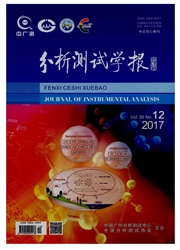

 中文摘要:
中文摘要:
在pH2.8HCOOH-HCOONa缓冲溶液中,半胱氨酸(Cys)可与金铂纳米粒子(AuPtNP)作用发生聚集,导致深红色的金铂纳米微粒变成蓝紫色。AuPtNP对甲酸还原磷钼酸生成磷钼蓝反应具有较强的催化作用。而金铂纳米粒子聚集体(AuPtNPA)的催化作用较弱。随着Cys浓度增大,体系中AuPtNPA增多,而AuPtNP减少,催化能力随之减弱,磷钼蓝在700nm处的吸光度值降低,Cys浓度在30~350nmol/L与其吸光度降低值△以呈良好的线性关系。检测限为28nmol/L,表观摩尔吸光系数为1.8X10^6L·mol^-1·cm^-1。据此建立了测定半胱氨酸的纳米金铂催化光度分析新方法。
 英文摘要:
英文摘要:
In the pH 2. 8 HCOOH-HCOONa buffer solution,the cysteine(Cys) interacted with gold-platinum nanoparticles (AuPtNP) to form aggregations that resulted in its color changing from wine red to blue-violet. The AuPtNP has a strong catalysis on the phosphomolybdate blue reaction of formic acidphosphomolybdic acid,but the AuPtNP aggregations (AuPtNPA) catalysis is weak. With the increase of Cys concentration,the AuPtNPA increased and the AuPtNP decreased,the catalysis decreased and the absorption value of phosphomolybdate blue at 700 nm decreased. The Cys concentrations in the range of 30~350 nmol/L had good linear response to the decreased absorption value AA,with a detection limit of 28 nmol/L, and its molar absorption coefficients was 1. 8 × 106^6 L · mo1^-1 · cm^-1. Thus, a new nanocatalytic spectrophotometric method is established for the determination of Cys.
 同期刊论文项目
同期刊论文项目
 同项目期刊论文
同项目期刊论文
 A new resonance Rayleigh scattering method for the determination of trace O-3 in air using rhodamine
A new resonance Rayleigh scattering method for the determination of trace O-3 in air using rhodamine Resonance scattering detection of trace melamine using aptamer-modified nanosilver probe as catalyst
Resonance scattering detection of trace melamine using aptamer-modified nanosilver probe as catalyst Colorimetric sensing of trace UO22+ by using nanogold-seeded nucleation amplification and label-free
Colorimetric sensing of trace UO22+ by using nanogold-seeded nucleation amplification and label-free Resonance Scattering Detection of Trace Hg2+ Using Aptamer-modified AuPd Nanoalloy Probe as Catalyst
Resonance Scattering Detection of Trace Hg2+ Using Aptamer-modified AuPd Nanoalloy Probe as Catalyst A Highly Sensitive Enzyme Catalytic Method for the Detection of Ethanol Based on Resonance Scatterin
A Highly Sensitive Enzyme Catalytic Method for the Detection of Ethanol Based on Resonance Scatterin Resonance scattering spectrum detection of trace UO22+ using nanogold probe as catalyst of Cu(II)-gl
Resonance scattering spectrum detection of trace UO22+ using nanogold probe as catalyst of Cu(II)-gl A Simple and Sensitive Nanocatalytic Fluorescence Method for the Determination of Folic Acid in Food
A Simple and Sensitive Nanocatalytic Fluorescence Method for the Determination of Folic Acid in Food A Rapid Surface-Enhanced Raman Scattering Method for the Determination of Trace Hg2+ Using Rhodamine
A Rapid Surface-Enhanced Raman Scattering Method for the Determination of Trace Hg2+ Using Rhodamine Free-Labeled Nanogold Catalytic Detection of Trace UO22+ Based on the Aptamer Reaction and Gold Part
Free-Labeled Nanogold Catalytic Detection of Trace UO22+ Based on the Aptamer Reaction and Gold Part A stable and reproducible nanosilver-aggregation-4-mercaptopyridine surface-enhanced Raman scatterin
A stable and reproducible nanosilver-aggregation-4-mercaptopyridine surface-enhanced Raman scatterin A Sensitive Surface-enhanced Raman Scattering Method for Determination of Melamine with Aptamer-modi
A Sensitive Surface-enhanced Raman Scattering Method for Determination of Melamine with Aptamer-modi Resonance Scattering Effect of Dopamine Product Particle and Its Application to Polyphenoloxidase Ac
Resonance Scattering Effect of Dopamine Product Particle and Its Application to Polyphenoloxidase Ac 期刊信息
期刊信息
